Intentional Marketing: A Summary of 12 Steps
Below is a summary of the 12 steps that Joanne O’Connell and I are including in our book. The title of the book at this point is, “Intentional Marketing: The Power of Measurement and Alignment”. We are aiming to publish this Fall. We are also working on developing a website for preorders.
If you have any feedback let me know.
Step 1 – Be Aware of Important Considerations
Here are six questions to help you get oriented and figure out where you are on a journey that represents the phases and steps of the Intentional Marketing System. Each question will help you think and prepare yourself as you start the rest of the journey.
Where are you now in your marketing journey?
What pieces of the Intentional Marketing System already exist in your company?
Are you math-oriented, both in using the numbers and in knowing how to find them?
Are you comfortable with flexibility and learning as you go?
Have you formed habits to keep you ahead of the curve in developments in digital marketing?
Are you able to adapt theory to your company’s situation?
Step 2 – Design the Model
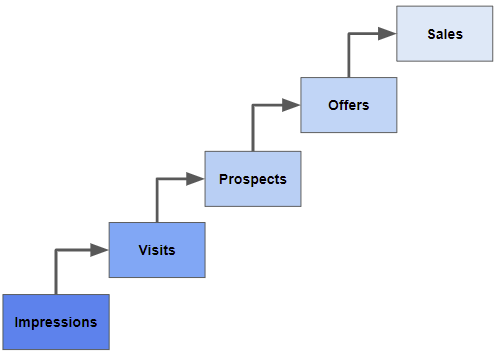
Step 2 involves designing the essential levels of the model for your application of the Intentional Marketing System. Over time, you will learn from the numbers collected and possibly modify the design, but you need to start somewhere. This step outlines a generic approach that can be adapted for your specific situation.
As well as identifying the levels of the model, you also need to identify the marketing channels you are using and collect the numbers related to the activity within each channel.
At the end of step 2, you will have a blueprint of the model and your marketing channels.
Step 3 – Collect the Measures

In step 3, you will populate your model with the measures that are relevant and useful. You should already have identified the components of the levels in step 2 – Design the Model. In step 3, you will learn how to source the actual numbers.
Business is never as simple as outlined in books, including this book. Every business is unique. Management is made up of people who have unique skills and experiences. Customers are always unique. Business processes are unique. And marketing is no exception.
Once you start sourcing the numbers to populate the model you will discover the uniqueness and complexity of your company.
Measures are numerical data; they are the result of quantifying. Understanding and using measures is a fundamental component of the Intentional Marketing System.
Step 4 – Calculate the Metrics
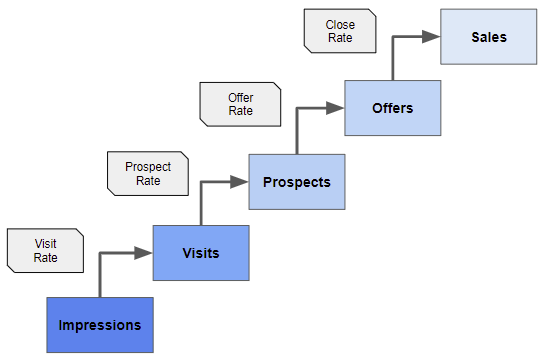
Step 4 brings us to the concept of metrics. This chapter focuses on how to use the measures collected to calculate metrics.
Metrics are important for understanding relationships and making comparisons.

In the Intentional Marketing System, metrics are numbers that are calculated from measures. They are developed to show the extent of marketing and business success. Metrics are often ratios (having a numerator and a denominator) that are associated with one or both of two qualities:
They track over time
They show proportion to something else

Measures on their own are valuable but only to a certain degree. For example, it is useful to know that the count of visitors increases from one month to the next. However, even more importantly, you will want to know conversion rates from one level—say, visits—to the next level (prospects). That reflects the effectiveness of your marketing. You will want to know the costs to realize a visit or an outcome. That reflects the efficiency of marketing. These calculations, based on measures, are metrics.
Metrics can be calculated after measures are gathered.
Step 5 – Generate a Marketing Statement
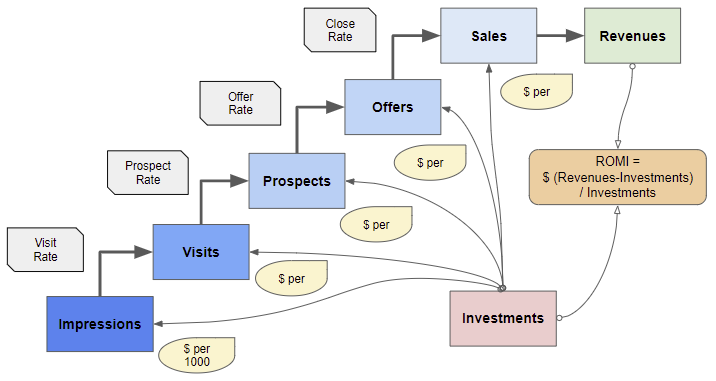
Now that you know that the numbers (measures and metrics) exist and can be collected, you can create a report. Before moving on to step 6 – Look Inside the Model to analyze the numbers in the model, it is valuable to create your marketing statement. This is a report of all the measures and metrics in the model.
Think of your marketing statement as filling a role similar to a financial income statement but focusing only on marketing. It is a comprehensive view of what is happening at all levels of the model. The statement should give a full picture of what is happening in marketing.
Assuming you have decided to track marketing numbers monthly, your marketing statement can be designed for just one month, or to make comparisons easier including the most recent thirteen months. The thirteen-month format allows you to easily make month-to-month comparisons for the current year and year-over-year comparisons for the most recent month (or year-to-date should you choose).
Step 6 – Look Inside the Model
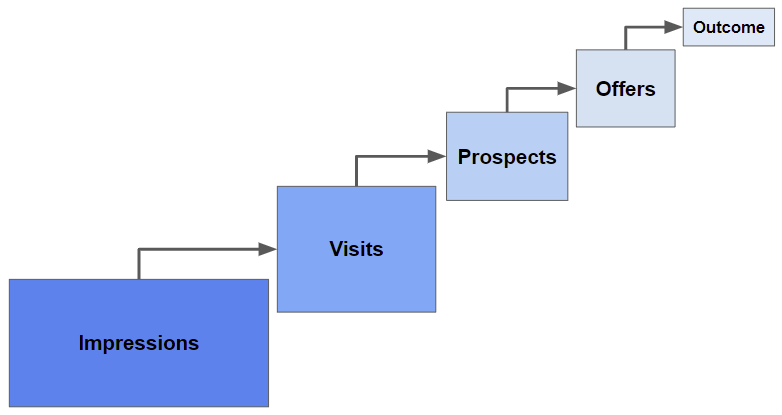
In step 6, the focus is to work with your marketing statement and ensure that your marketing model is represented by the model. Efforts should be made to look at the measures and the metrics to see if there is (or is not) a strong performance from top to bottom. You should start by reviewing the measures and metrics and, ideally, you should end up with a good understanding of your baseline performance.
Learning about your baseline is important. Think of your “baseline” as what you usually achieve. It is the “normal” or the “average” against which you will rate the impact of changes to circumstances including marketing. The baseline is the starting point for analysis.
As you look at the numbers inside the model you should identify outcomes in relation to marketing spending amounts and activity.
Step 7 – Analyze the Numbers Inside the Model
The focus of step 7 is to identify the choices that can be considered to optimize marketing performance.
Marketing can be complex. Finding your baseline in step 6 should show you how many factors are at play for obtaining a sale. The more factors, the more likely that the model will be complex. Marketers often look at what they have done so far and ask themselves:
I want to do better, where do I begin?
What matters first?
What follows next?
Marketers at this stage often want to accomplish one or more of the following:
Increase the measures for the ultimate outcome (more sales)
Decrease marketing costs
Simultaneously accomplish both of the first two points
Step 8 – Actions to Optimize Performance
Step 8 is where you make concrete plans to go forward. Step 8 assumes that you have identified areas where your current marketing performance could be improved.
By the time you complete step 8, you should know which measures and metrics you will need to work on, to improve. Ask yourself these questions:
Which actions will change the measures that need changing and in the direction that you intend?
Which actions will have the most leverage?
Which actions could potentially generate the most improvements in performance?
Step 9 – Look Outside the Model
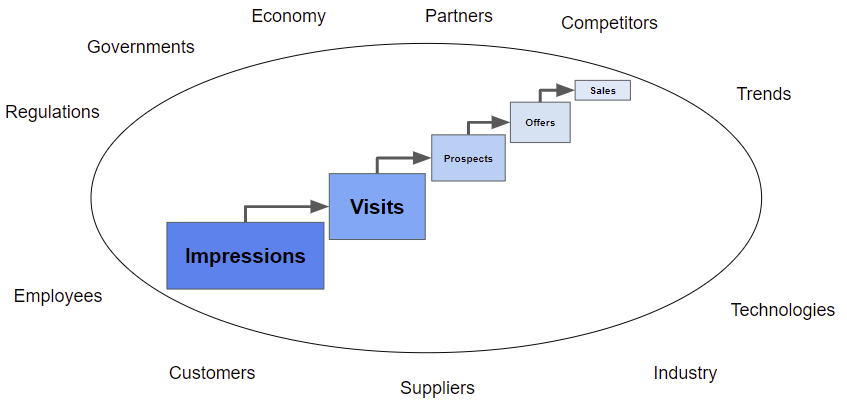
As explained in the previous section, the ultimate goal of the Intentional Marketing System is to improve alignment between your product, your market, and marketing where the three components and their alignment satisfy the needs of the company.
To achieve this, marketers must gain insight by studying influencing forces external to the company. This requires them to look “outside the model” of the company’s current marketing.
Looking outside the model will help the marketer and business leaders understand what is happening externally in order to make sound decisions related to the future of the company and its position in your marketplace. Decisions related to marketing need to be made in the context of the economic, social, and business environment of the company—not only as the accepted “facts” define them but as people in your market perceive the company and its products.
The actions taken by looking outside the model will enlighten you concerning critical topics of:
Why do customers in the market purchase your products
How your company interacts with your market, i.e., current customers and potential customers
The value of your product within your marketplace of competitive alternatives
Why do some customers stay with you and some leave and maybe buy from competitors?
The economic, social, and technical trends which influence your marketplace
The purpose of gathering and using the information in step 9 is to understand why buyers make the choices that they do and whether the reasons they use will persist into the future.
Step 10 – Interpret Findings and Classify Your Company’s Situation
In step 10, the emphasis is to understand how the concept of alignment best applies to your company. By following step 10, you will determine which element or elements—your product, your market, or your marketing—you wish to keep as is, and which element you may need to revise or change completely.
Often one element will be stronger than the other two, but that is not always so. Sometimes your company will be strong in two elements, and as a result, you will only need to focus on bringing the weak element into alignment. Consider the strong elements as a foundation for bringing the other elements into alignment.
Our illustration for good alignment looks like this:

Step 11 – Develop a Plan to Improve Alignment
If you reach this step, then you are using the Intentional Marketing System to its full power. By now, you should have a thorough understanding of your company’s strengths and shortcomings, and you know which elements need to be brought into alignment.
In step 11, you will develop options, set priorities, and create a plan to improve alignment based on the resources of investments and effort that you have and the window of time you have to make changes.
The aim of step 11 is to bring the elements of product, market, and marketing into alignment. Ideally, all three elements should be working together efficiently and effectively. As a marketer, you will know when the system is in alignment because:
People in your market are buying your product
Investments made in marketing are sustainable
ROMI is in the sweet spot
The intentions you decide to take will depend on the situation you defined for yourself at the end of step 10
From step 10, you should have identified which of the three components—product, market, and marketing—is your strength and which components need to be improved and brought into alignment. The component where you have the most strengths becomes your foundation. In most cases, the foundation will be either the product or the market.
If the Product is the Foundation, then
Identify or clarify the market
Fix marketing
If the Market is the Foundation, then
Fix the product, if needed
Fix marketing
If the Product and the Market are Both Strong, then
Fix marketing
Step 12 – Choose Where to Restart

Products, markets, and marketing channels are constantly evolving, as a result, the purpose of step 12 is to review the entire Intentional Marketing System.
The first decision in this step is to choose where to start your evaluation to make improvements. To improve performance and alignment, there are three possible starting points:
Step 2 – Design the Model: Rebuild the model by working through steps 2, 3, 4, and 5.
Step 6 – Look Inside the Model: Redo steps 6, 7, and 8 to optimize the performance of marketing by improving the numbers in the model
Step 9 – Look Outside the Model: Improve the Alignment of the product, market, and marketing by working through steps 9 to 11
A Final Word
We hope that you have risen to the challenges and grown from finding solutions:
You know how to find the right marketing measures
You have gained a new and helpful system to evaluate, measure, and align your current and future marketing activities
You have gained a vocabulary to share with your motivated marketing team
Your comfort with marketing math has grown
You are able to keep the ship afloat as you develop new approaches
You are more knowledgeable about evolving marketing choices than you were before.
We also hope that you have found that:
Revenues based on intentional investments in marketing have grown
You are able to maintain the alignment of your company’s product, market, and marketing over time
You have said “goodbye” to random marketing based on a whim and said “hello” to the foundations of purposeful analysis and intentional marketing.
We applaud you and thank you for your patience and commitment.
Well done.